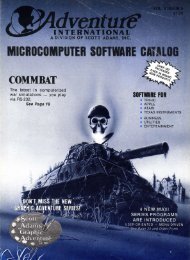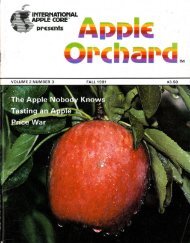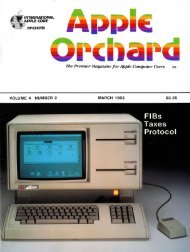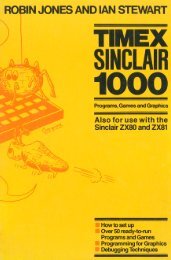Create successful ePaper yourself
Turn your PDF publications into a flip-book with our unique Google optimized e-Paper software.
IAC Disks of the Month<br />
Review by Barry D. Bayer<br />
B<br />
ack in the early days of Integer<br />
BASIC, (that's the one with the '>'<br />
prompt) there were very few commercial<br />
programs available for the Apple<br />
IL Pioneer programmers, after developing<br />
a program of which they were particularly<br />
proud, wanted to share it with<br />
their fellow 10,000 or 20,000 Apple users.<br />
The easiest way to do this was to send the<br />
program to Apple, which took the best<br />
programs and distributed them free of<br />
charge to Apple dealers, who would let<br />
end users copy them for a small charge,<br />
or no charge at all. (Apple also seems to<br />
have hired many of the authors of these<br />
programs, but that's another story.)<br />
As Apple Computer, Inc. got bigger,<br />
and commercial programs began to<br />
crowd each other off the dealers' shelves,<br />
contributed software, as an Apple Computer,<br />
Inc. function, fell by the wayside.<br />
But in the IAC, contributed software still<br />
lives.<br />
One of the benefits enjoyed by an<br />
Apple Users Group belonging to the<br />
International Apple Core is the software,<br />
usually in the public domain and therefore<br />
legally copyable, usually distributed<br />
as the IAC Disk of the Month. DOMs<br />
become part of each member club's<br />
software library, and are distributed by<br />
most member clubs to their members at<br />
prices approximating the price of a quality<br />
blank disk In addition, DOMs are<br />
available to individuals, and other nonmembers<br />
of the IAC, direct from the IAC<br />
at a cost of $25 per disk plus $3 per<br />
shipment for postage and handling. But<br />
we'd rather you join an IAC member club,<br />
instead, and get the programs on the<br />
DOM from your club. DOM programs<br />
mostly originate from members of our<br />
member clubs who are kind enough to<br />
share their work and ideas with the IAC's<br />
400 plus member clubs.<br />
DOM will be a regular feature in Apple<br />
Orchard, which will feature the most<br />
recent DOM available and, as these<br />
things go back a couple of years, an<br />
occasional "oldy but goody". We should<br />
note that DOMs do not contain, in the<br />
main, professional quality documenta-<br />
64 Apple Orchard<br />
tion and menus, and tend to crash, a bit,<br />
when presented with an unforeseen error.<br />
(We are told by the commercial software<br />
publishers that complete debugging of a<br />
program of any size takes thousands of<br />
man hours of work While all programs<br />
are tested and are believed to be accurate,<br />
it is obvious that thousands of man hours<br />
have not been spent on debugging.) On<br />
the other hand, DOM programs are<br />
usually copyable, listable, alterable,<br />
improvable and generally contain understandable<br />
examples of "how to do it''.<br />
The March, 1983, DOM is a disk prepared<br />
by the IAC's Education Special<br />
Interest Group (SIG), and differs a bit<br />
from the usual. First of all, it was prepared<br />
with the assistance of ABC Software of<br />
Sacramento, California and Computer<br />
Advanced Ideas of Berkeley, CA. Second,<br />
the disk is almost entirely in compiled<br />
Integer BASIC (using Chris Galfo' s compiler),<br />
and is therefore not easily listable,<br />
alterable, etc. But it does have a number<br />
of well conceived programs which<br />
should find a place in any grade school<br />
classroom. Programmers noted on the<br />
disk include Tim Aaronson, Ted Cohn,<br />
Dave Daughtery, Andy Herzfeld, Ted<br />
Perry (our EdSIG chairman), Pete Rowe<br />
(of "Game Show" fame), Linda Slovick,<br />
Lawrence You, Geoff Zawolkow, and<br />
Barry Cole.<br />
Boot the disk, and you will be presented<br />
with a distinctive high resolution<br />
graphics display which is almost worth<br />
the price of the disk (I'm going to keep<br />
the topic secret, but the kids will love it)<br />
Eventually you will get to a menu which<br />
will permit the running of nine programs.<br />
BOXES tests for single digit addition<br />
and subtraction skills in a way that will<br />
please first and second graders.<br />
DRILL is an addition/subtraction/ multiplication/<br />
division quiz program which<br />
has delighted my 8 year old. The user<br />
chooses the operation to be tested, the<br />
level of difficulty, and the time to be<br />
permitted for each question. The program<br />
then relentlessly provides problem<br />
after problem in the form<br />
2 + 7 =<br />
and immediately marks the player's response<br />
as ' C' or' X'. At the end of the series,<br />
the percentage of 'C' answers is given,<br />
and the player is offered the chance to<br />
exit or try another series. For children in<br />
the process of learning their number<br />
facts, a program like this is a necessity.<br />
ADRILL is just like DRILL, but adds the<br />
complication of signed numbers.<br />
<strong>APPLE</strong> BARREL and <strong>APPLE</strong> ARRAY<br />
use the same graphics and story requesting<br />
the user to enter the number of apples<br />
that are harvested and placed into a<br />
barrel. In <strong>APPLE</strong> ARRAY, the Apples are<br />
stacked neatly into equal length rows, so<br />
that the program is, in reality, a clever<br />
multiplication test<br />
FRED FRACTION tests arithmetic<br />
manipulations of fractions, using a very<br />
clever animated graphics scene to draw<br />
the user into the program. Some teacher<br />
might not like the program's habit of<br />
accepting 13/ 12 in addition to 1 1/ 12,<br />
but the kids will love it<br />
MAKING CHANGE uses Hi-Res<br />
graphics representations of dollar bills,<br />
quarters, dimes, nickles and pennies, and<br />
quizzes the player with appropriate<br />
change problems. Some cashiers I know<br />
could use a bit of training with this.<br />
XZONE is the last game on the disk A<br />
19 by 19 grid is presented. Using coordinates<br />
from 0,0 in the lower left, to 19, 19 in<br />
the upper right, the player is invited to<br />
inspect the grid cell by cell, and determine<br />
where two secret (undisplayed)<br />
lines intersect This will keep the older<br />
kids entranced for quite a while.<br />
The final program on the disk is not a<br />
game, but a program which converts the<br />
Apple into a sort of oscilloscope, displaying<br />
the " voice print" of sound input into<br />
the Apple through the casette input port<br />
The instructions say it is for use in speech<br />
therapy, but it also presents some good<br />
clean fun.<br />
Once again, DOM 24 is available from<br />
the IAC direct at a high outrageous price.<br />
But we'd rather you pick it up from your<br />
local Apple User Group. It







